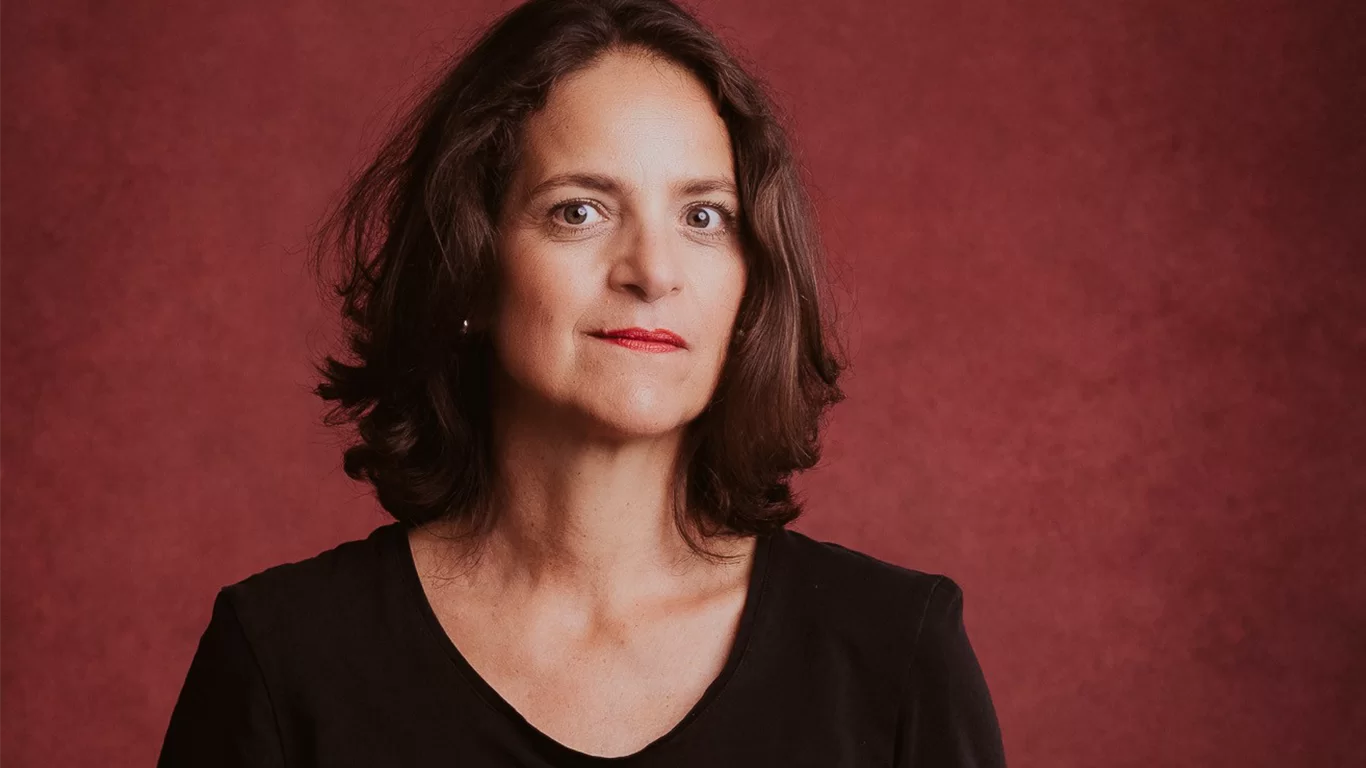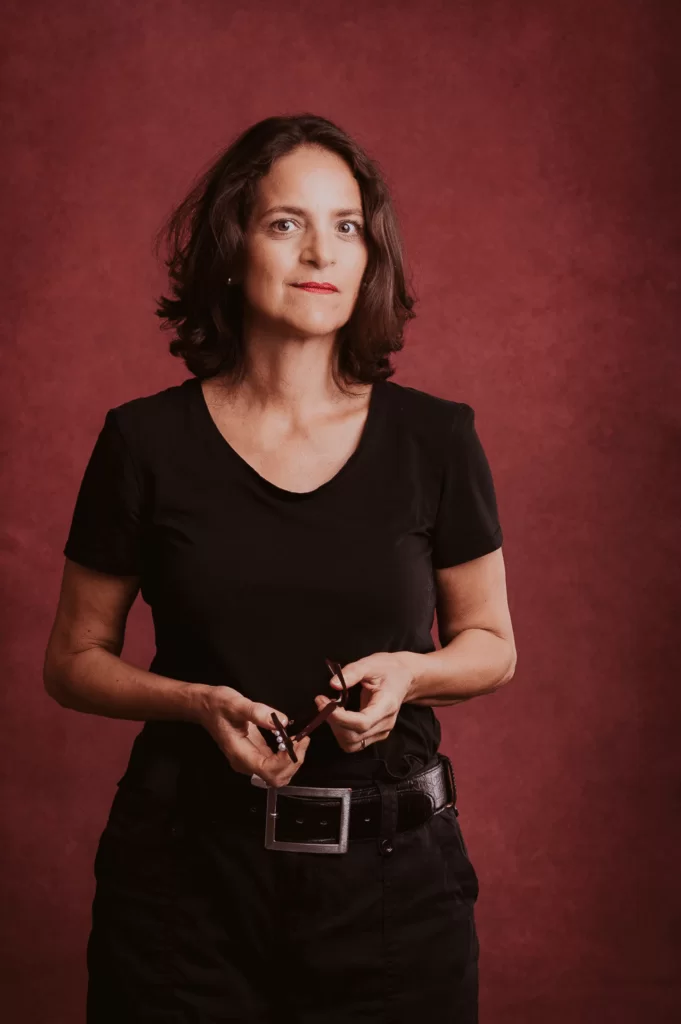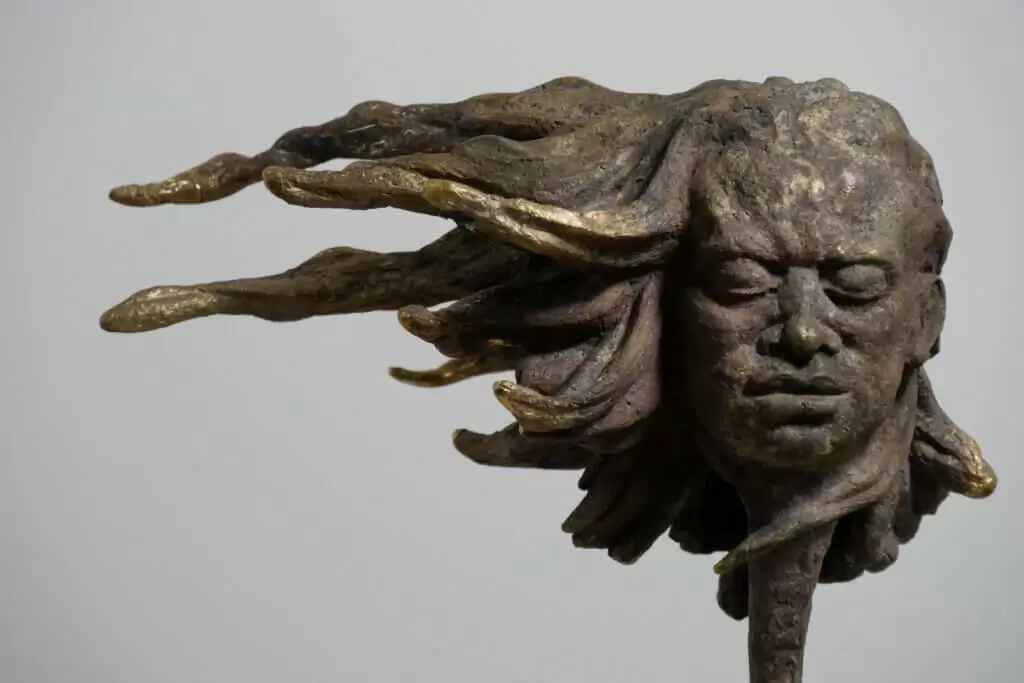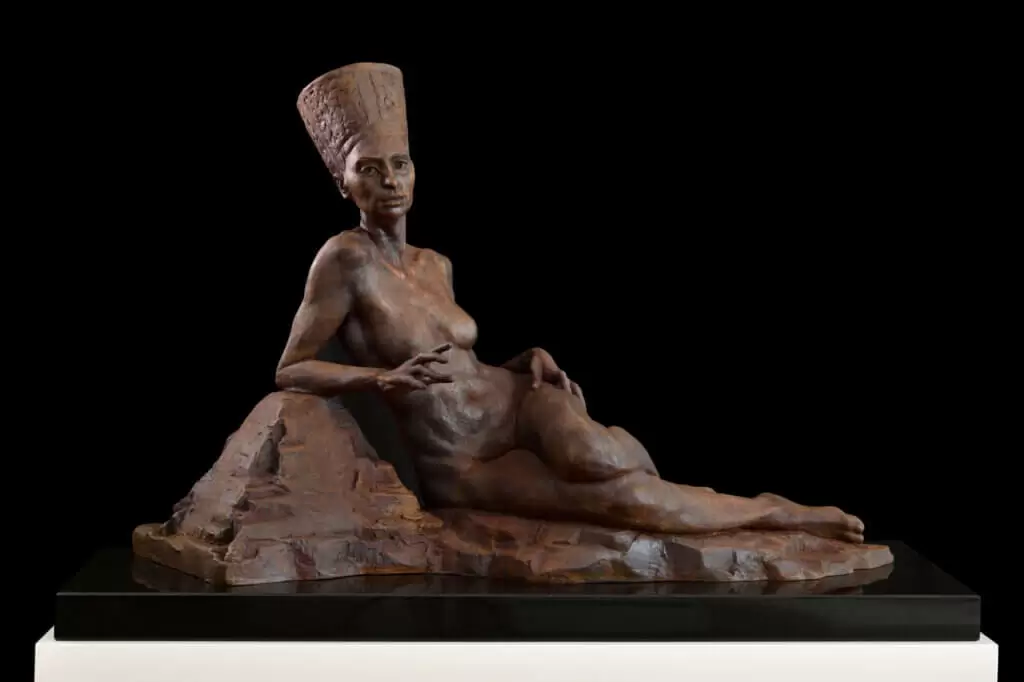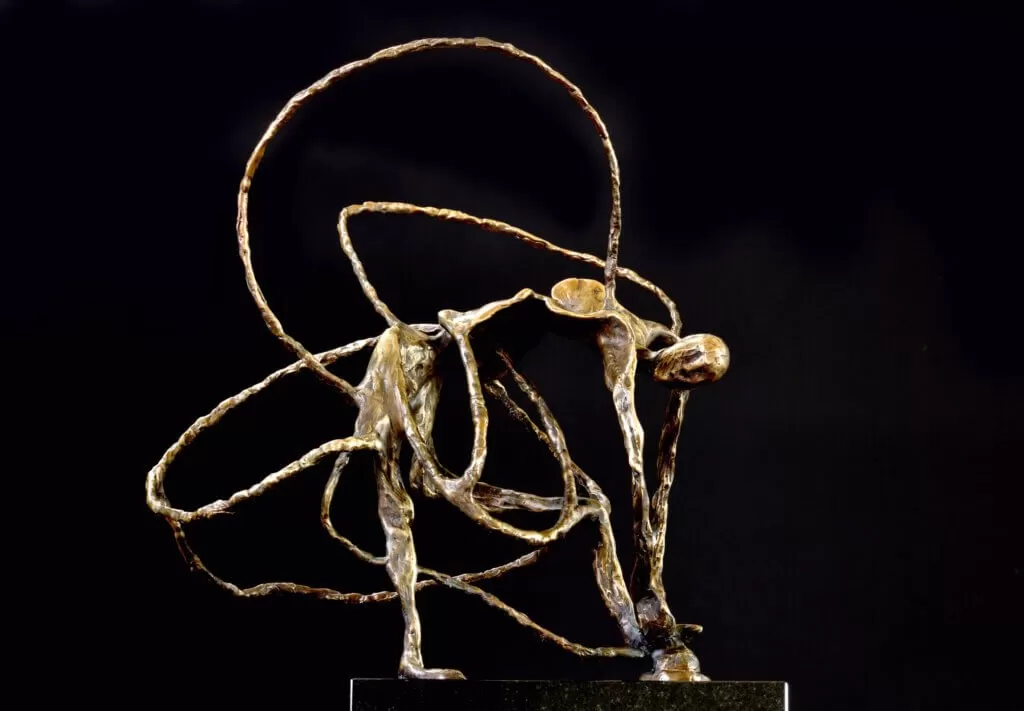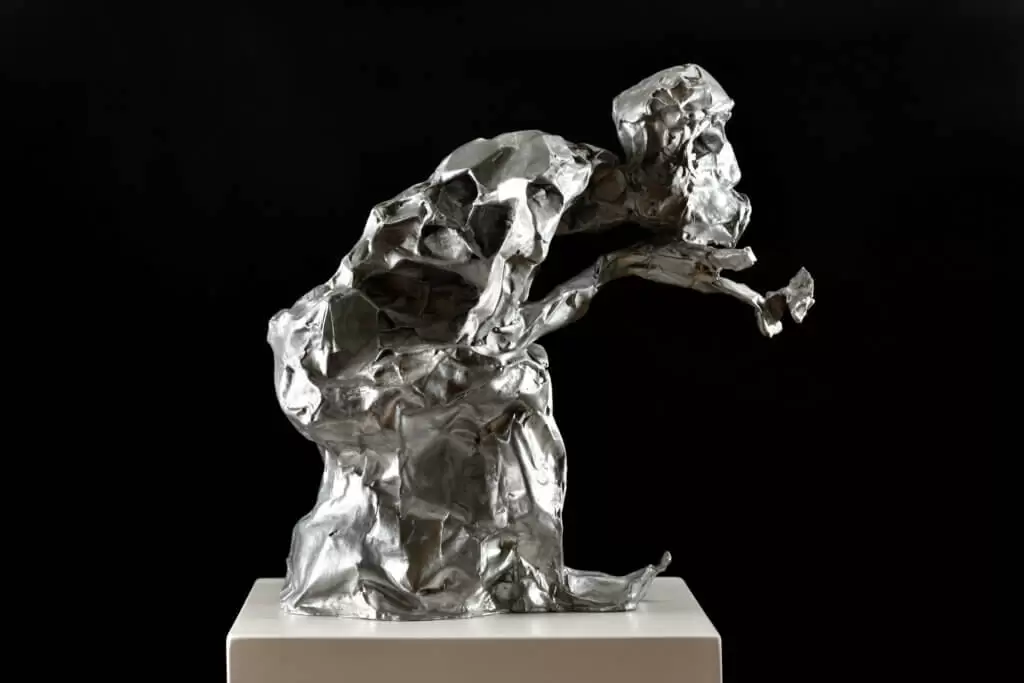Dr Gindi on the influence of non-Western thought in her sculptural work In a time when art seems to behave simplistically, Dr Gindi’s work moves beyond the quotidian, bending back the premises that otherwise keep things in line.
As sculptor with Egyptian roots, she practices art as philosophy and provokes alternative ways of perception – a non-Western, non-Cartesian gaze that notices the fluid and fractured reality we are living in.
I am interested in the motion of time. Trying to incorporate circular aspects of time, some parts of my sculptures are embodied with pliant, biomorphic forms, others are spongier and ostensibly pulsating.
Dr Gindi
In every sculptural encounter, Dr Gindi withholds as much as she reveals – she is not as concise as contemporary proliferation would wish her to be. Leveling the intermittence between interest and inertia, she models the infinity of human existence. I had the privilege of speaking with Dr Gindi about the importance of non-Western thought in her sculptural practice, her views on reaching the infinite, and her current projects.
Q: Dr Gindi, it is a great pleasure speaking to you today. You were once called a ‘philosopher of sculptors, and a sculptor of philosophers.’ Is your worldview mainly confined to what is usually named the Western framework of thought or are you open to non-Western philosophical schools’ descriptions of your artwork? If the later, how can non-Western perspectives add to philosophical discourse in general and to the arts in particular? What led you to search for other ways of reasoning, beyond the mainstream?
A: As curious adolescent, I read every philosophical text I could my hands on, from Plato to Polanyi. Perhaps driven by my own heritage – I am Egyptian born albeit raised in Europe, and with a certain despondency with all socio-political certainties, I soon tumbled into Zen Koans, Sufi texts, and Daoist writings as well as the Hopi path of life stemming from indigenous America. I loved the zest of those writings – a mix of philosophy, religion, literature, and yes, the arts – as the arts make the invisible visible.
I came across the Buddhist notion of nirvana, the Sufi principle of takhliyah, as well as xinshu, Daoism’s duality of heart and mind. All epitomize the emptiness and paucity that their followers feel when getting close to the Absolute. And I noticed that contemplation and introspection are far from what traditional Western thought is meant to teach us. I realized, after all, that philosophy originates not just from Europe. There are notable non-European intellectual traditions, manifold philosophical schools from China, India, Africa and pre-Columbian America. European philosophy as the default tradition of our thinking just happens to be our tradition, starting with Plato – and for rather historical reasons.
But what exactly is non-Western philosophy? Do the various schools have anything in common? Non-Western philosophy as a fancy style seems to be often latched together as a snappy response to the classificatory self-confidence of the West. Non-Western philosophy is a sort of euphemism for occultism, orientalism, spiritualism, for ‘not really being philosophy’ – illustrating a view that everything from Egypt to Ecuador is essentially the same; and often proclaiming that indigenous philosophies are mostly wrapped up in cultural legacies and dependencies on myth, thus not able to pose as universal theories.
I cannot disagree more: The Non-Western philosophical tradition is enormously rich and diverse. Al-Farabi in the Islamic world, the Vedic teacher Ashvalayana in ancient India, Laozi in Taoist China as well as many others philosophers from around the (non-Western) world, including contemporary thinkers: all have made contributions within their own immediate intellectual contexts, but also had a significant impact on Western metaphysics, hermeneutics, logic and ethics. The point is simply that, for reasons of cultural domination, most non-Western thinkers are relatively unknown to contemporary western philosophy.
In my practice, I am harnessing rudiments of non-Western thought, but my objective is not to produce non-Western art per se. Rather, I want to establish a system of connections by an intuitive process of coalescing Western and non-Western thought through sculpture. And, well, my practice is endlessly in a state of becoming and never quite complete.
Q: As a cornerstone to this conversation, could you try to cut to the chase of non-Western thought, as arduous such undertaking might be? What is non-Western philosophy in your own words?
A: It is rather difficult to generalize thought originating from the East and the Global South, across time and space. Let me give it a try – and I want to immediately apologize for such a crude simplification: Many Non-Western philosophies are fundamentally different from their Western counterparts in their perception of time, valuation of reason, and veneration of active life vis-à-vis contemplation.
Let me explain further: Western philosophers mostly adhere to the predominance of linear time, everything is structured, sorted and classified – time moves forward without repeating itself. Kant associated the idea of linear time with progress, growth and dominance. Eastern and Southern philosophers much more think in principles of circular time, of orderly chaos. In The Analects, Confucius sitting by a river proclaimed: ‘Time passes on like that, indeed, not ceasing day or night.’ Time flows within a process that holds together repetition and transformation.
Secondly, non-Western philosophies – pre-Cartesian or post-Cartesian – often appear as anti-rationalist. They rather emphasize the limits of reason, especially when it comes to explaining or justifying moral judgments. Taking again an example from ancient China: late 4th century BC philosopher Zhuangzi reflected on the normativity shaped by dao – the natural path we are taking – in a rather anti-rational way. He proposed that we should educate ourselves to become spontaneous in our daily interactions, rather than blocking ourselves through what we think of as rational acting.
Thirdly, non-Western philosophies often make a counterpoint to Aristotle and Hannah Arendt who praised the vita activa. Rather, they proclaim the non-action, or what the Daoist call wu-wei – often translated with ‘effortless action’, or – according to my understanding – a vita contemplativa. Wu-wei is not about laziness and complacency, it is about the conservation of energy – for the right moment, for the mystical transformation into infinity. It is similar to the Indian concept of karma – meaning ‘action’ in Sanskrit, which determines the future modes of an individual’s existence. Wu-wei and karma are two sides of the same coin – both contour the infinite within the framework of the ‘right’ action.
Western philosophers are mostly trying to make things plain and clear whereas their non-Western counterparts are often complicating and reversing things if we look at them with Western eyes.
Q: Perhaps one way to discern the infinite is to indulge in specificity, so let’s turn to the specifics of your work. How do you translate philosophy in general and non-Western philosophy in particular into your sculptures? And, most essentially, why does infinity never end?
A: I usually commence with an elaborate thought process, drawing on philosophy – both non-Western and Western – being rather agnostic on where my thoughts come from as they are permanently kneaded, folded, amalgamated. The non-linear, anti-rational, non-active takes a wide-ranging emphasis though. I love those three pillars of non-Western traditions as they are full of contradictions, but unlike Western philosophies, their contradictions are not seen as problems to solve.
Take for example the notions of yin and yang in ancient Chinese wisdom. Seemingly oppositional forces, but both are complementary and necessary to achieve balance and harmony. After, and with my ongoing thought process, I distill my ruminations into visual constructs, always hinting at the infinite as ultimate goal in life. I know, Infinity is a very large idea, it never ends as it is beyond any known precept.
Let me explain the human thriving for infinity with my sculpture Beaufort 7. The character depicted here is on a long journey, trying to return to his unknown home. That hero – or rather anti-hero – is sensing the mist of the sea on his face; the current may bear him far. Setting sail, he entrusts his soul to the wind. Just as in the Chinese novel ‘Journey to the West’ concerning the legendary pilgrimage of the Tang dynasty Buddhist monk Xuanzang – he will return after many trials and much suffering.
Like him, my entranced hero confronts and deals with the inevitable challenges that we all confront. He is going to become who he is, across the reaches of the sea, flushed by the waves, paying respect to the cogency of the human grit required to endure the trials of life, sailing through life by configuring his soul for balance and harmony.
The ‘Beaufort 7’ character is relaxing into the states that we human beings consistently run across in reality: uncertainty, conflict and discomfort. He is relaxed enough to see that there are no big difference between those states and their opposites that he desires: certainty, peace and pleasure. They come and pass on quickly, like waves on an ocean. And unendingly, his lush hair is streaming in the fickle wind.
Q: I understand, ‘Beaufort 7’ is a true symbol for the search of infinity – that unlimited and timeless space you are endeavoring to bring to us. What exactly is infinity and how do you root it in the philosophical tradition of non-Western thought?
A: This is a great observation; I am glad you see Beaufort 7 symbolizing the search for infinity. Infinity – for me – is the highest state human beings can achieve, as there is no desire and, by that means, no delusion. In Buddhism, infinity translates as nirvana, literally meaning ‘extinguishing’, or more precisely ‘the complete extinguishing of delusion. Or rather, ‘supreme consciousness, genuine understanding, pure freedom.’ Further to Buddhism, it is the Indic view of the world, the fulcrum of thought which gave rise to three major world views: Buddhism, Hinduism, and Jainism, all of which initiate rebirth, non-binary time, and a universe where there are no limits, as everything is nothing.
Such worldview is in stern contrast to the Greek belief that the world effectuates as chaos until the Devine forces create order. It is also contrasting with the Abrahamic views where God creates the world out of nothing. And the world thus conceived has a certain end: the Apocalypse. The Greek and Abrahamic legacies led to the dominant Western view that is infatuated with structure and is terrified of disarray, and uncertainty – something Indians and other ‘indigenous’ peoples are habituated to and even thriving in. The yearning for infinity makes attainments pointless, and puts the focus on sageness.
Different from the quantitative approach taken by the Greeks that migrated into mainstream Western perception, much of Eastern thought flows around qualitative infinity. The Indian tradition, in particular, points to one main revelation: Enlightenment – an experience that has different names in the various traditions — nirvana, moksha, kaivalya, etc. Enlightenment is intellectually inconceivable; it cannot be attained through conceptual reasoning, because it absconds all categories of thought.
I think that nirvana – respectively moksha and kaivalya – is something that is intuited rather than unearthed. Look at my sculpture called Interstellar Dilemma: A foot and a hand are moving together, apart. Seemingly rooted in the here and now, yet we seem to strive for distant elevation. Is there such existence as matter without energy, and Earth without the Divine? At the most evident level, the answer is plain. After all, what can we conceivably conclude about humankind’s perpetual search for selfhood, a search dedicated to the desire to overcome the end?
Q: In fact, many of your works seem to explore nirvana, aka infinity, as motion where time expands and subsides, thereby embodying a cohesive experience of spatiality. Your recent sculpture Transfigured Immortality is a great example of such striking phenomena. Could you let us know what inspired you to create this sculpture?
A: When sculpting, I often hold back in anticipation of the discovery of the infinite. And I try to recollect extrasensory phenomena, placing them in the context of their fluid being, like the ancient Egyptians did. Hoping that infinity occurs in the world to which they journeyed after death, they believed in the sun god Re and his victory over darkness and evil. The remarkable gifts of the river Nile, with its annual flood and unique fertility, encouraged them to assume that inner and outer peace could be sustained while fitful famine, destruction, and disease reminded the people that peace was not an absolute given. They were yearning for infinity whilst thriving in potential uncertainty. Likewise, a few millennia later and still today, the dervishes in the Sufi tradition spin their bodies in repetitive circles like planets in the solar system orbiting the sun – aiming to reach the infinite.
The great tombs in the Valley of the Kings were sculpted and painted with depictions of eternal afterlife. Ceremonial objects were offered to provide the deceased with the essentials to reach infinity. Once mummified, the deceased was expected to be reborn. Still, they did not view their own rebirth in the next world as preordained: an exemplary life which goes beyond the mere appearance of humanity shall enable infinity. Enthused by my Egyptian heritage, I wanted to explore with Transfigured Immortality the essence of infinity in Egyptian thought. The sculpture shows a graceful lady—some might say a Pharaonic queen—in the prime of her life, leaning on her last place of rest. She reflects upon the dark spots of her existence, rimmed by scattered light glistening from the deep. By accepting the world beyond, she illuminates her present life in dignity. It is not eternal death but the lightness of infinity that I try to capture in that sculpture.
In every respect, the graceful lady is leading an exemplary life. She is longing for remembrance won through dedication to a cause beyond herself, a whole new cosmos that evolves its own stars. She is at one with her people. Indian thinkers studying ancient Egyptian texts would later call such union the nirvana.
Q: Your works are never exactly patterned, but rather integrate layers of matter circulating from an innermost, often frail core. Are you sculpting time into a unit of the past? And do you think in circular and many-hued forms?
A: I am interested in the motion of time. Trying to incorporate circular aspects of time, some parts of my sculptures are embodied with pliant, biomorphic forms, others are spongier and ostensibly pulsating. Well, indeed rather unconsciously, I withstand the dominance of linear time in Western though that always tries to order incidents into past, present and future, a sequence in which the concept of progress is rooted.
I henceforth also reject the Kantian constructionist view of the self as the product of reason penned in measurable time. And I neither sculpt time into the past nor into the future. In She that spreads the winds, for example, you can embryonically feel the non-linear Fluidity of Being – the name of a new series I am currently developing. Reality is characterized by becoming — not by being. On a lucent day the exhilarated wings of that female character are unfolding into the melody of breath. Airiness surrounds her.
Many non-Western traditions hold that beginning and end are equal as time essentially is cyclical. Cyclicality allows us to visualize going backwards or forwards, at no point coming up against an ultimate spike. A variety of philosophical schools contain elements of cyclical thinking about time, perhaps most evident in classical Indian philosophy – all life is constantly being reborn from an infinite past in a process of reincarnation.
In addition, East Asian thought is rooted in the cycle of the seasons, part of a larger whirl of existence. In notions of Chinese traditions, in particular, truth is timeless. Bringing a Non-Asian perspective into the discussion: Aztec metaphysics embraced an ontological and constitutional oneness, despite the appearance of diversity in the world. At the heart of Aztec metaphysics stands the thesis that there innately exists just one thing: dynamic, vivifying, eternally self-regenerating energy – time and space are single seamless unity.
Likewise, the indigenous American Hopi tribe’s philosophy of nature and the Southern African Ubuntu philosophy defines time as universal bond of sharing that connects all beings and the elements they are made of – concepts similar to quantum physics that developed in the West much later: energy gathers into matter, as kernel of human being. And we are all bound to nature.
Interesting in this regard is the perception of the universal and inescapable phenomenon of death. In the West, we mostly agree with René Descartes that we ultimately cease to exist as our organs stop to function, as they are nothing more than machines. Earlier, Plato suggested we view death as the achievement of life, helping us to see death is inevitable. Divergently, many non-Western accounts of death are not so much about bodily decay as about the return of energy to the place of inception with which it re-identifies.
I tried to relate such understanding to The Last Second, another work in the series Fluidity of Being, where I present a forlorn character at the last movements of life. Beclouding and becoming coincides – that perishing fellow might enter a rather serene espousal of the collective space of consciousness.
It is the power of the infinite that transforms his suffering, enabling him to surmount his own mortality and to become the celebrant of his eternal imagination. Death is not the end of life but rather the assumption of a different dimension. Nothing exists purely as a point on a map or a moment in time: everything stands in relation to everything else. I am following here the Buddhist view of anatta, the no-self: arguing that personhood is equivalent to a bundle of states and properties beneath. And yes, I think in circular and even many-hued forms.
Q: I admire the spirit of contradiction in your view of the non-self in time and space, exemplified by the wispy and transient characters you are modelling. They sometimes appear lost, beyond any valuation of reason. What and where is the place of humans in that sort of timeless fluidity?
A: I reflect about the non-self, that is why I am who I am – I love contradictions. But let me explain: I am not in favor of any nihilistic denial of reality. I show human beings in all their agony and suffering, for example in Fear is Hunting You and Shame, two recent sculptures in the series Fractured Reality.
Whilst exploring the blind spots and open wounds of human nature, the series recites a dialogic prose to illustrate inner discontents – in all its conceivable facets and intensities. The works in this clustered sequence are portrayals of possible states of being in its hypothetical enmeshment that sometimes let the protagonists fulminate or silently implode, thus detaching them from the possible reclamation of infinity.
Fear is Hunting You depicts a humanoid creature, a kind of nameless lurch, stirring us with piercing fury. Appallingly, there is no need for unbearable screams. The creature’s chained corpse is fed by a ghastlier fear – the unborn dawn. Fear is an ever teasing and stabbing tribulation, making us do a diverse range of erratic things, often way out of proportion to the hazard posited by the object of fear. In the sculpture of the same title, Shame looms up from the clouded silence, sensing the chant of the breathing glare. Frailty forms on the face of a nebbish character. Unlike vague disgust, shame is directed not towards other persons but towards ourselves. We cross our arms in front of our pitiful heads to ward off the gazes of others, and finally to protect ourselves. This constant self-flagellation is tiring and gloomy.
My artistic practice is all about the release from such suffering. Rather than blocking ourselves through what we think of as rational acting, I follow Thich Nhat Hanh, the monk and Zen master who died earlier this year, suggesting one reduces the belief in rational acting. Western cosmology in contrast, not only since René Descartes but originating from Ancient Greek ethics, is cursed by a harrowing split of body and mind, and is based on the exceptionalism of the human mind – leading to a constant tension of what we should do and what not. Rationalized and compartmentalized, we are in constant fear, and feel ashamed if we don’t live up to the expectations of others – alienated, disembodied and lonely.
Buddhism, Hinduism and Jainism interpreted life as consisting in an intrinsic state of suffering, and offered tonic ways for coming to terms with and eventually mastering the root causes of that suffering. With the Upanishads, in particular, Indian scholars aspired to liberate human consciousness from its limitations and fragility. And they emphasized the connection to forces larger than the self/non-self, often not visible but felt, as part of that process. Most non-Western cultures see human beings as relational entities, embedded in the context of humanity and nature at large.
Q: So, what are those tonic ways to master human transformation? Is there a metaphysical or even mystic dimension in your work? How to reach infinity?
A: The idea of transformation has always been a central idea that I follow in my work – a genuine metaphysical transformation based on contemplation rather than on action. In Reverie is a piece in the series Finding Ways that endeavors to launch a universal inquiry into the existential arousal of infinity. If anything, I want to offer the idea that we need to be able to lose control, acknowledging that a life of motion also requires contentment. In Reverie depicts a joust between determination and deliberation in a female figure blowing the seeds off a flower, in a rather naïve and mindful manner. She feels completely at peace with herself. Her thoughts permeate the air, everyone can breathe them in. Nurturing a holistic understanding of the world, that female figure navigates life from a place of no-mind, as in Buddhist meditation.
Likewise, the character in The Horticulturist is an alluring but bizarre creature germinating his infinite self. Nothing to hide and lose, he seems to believe that the flowers that grow on earth will tell us how to let being and beings be. Imagination and incarnation federate at the entrance of his garden. I would even say that his understanding from being a gardener is that life is magic. He is in an altered state of consciousness, a sort of plea against the growing rationalism of western society.
My work surely emphasizes metaphysical transformation, with a mystical twist. My practice is perhaps mystical in the sense that it aims at the identification of the true nature of existence, and lives according to it. Sudden insights might happen, like in the Zen or the Sufi traditions – a sort of ecstasy or altered state of consciousness enabling us to reach infinity as transcendent reality. Meditation and self-restraint are the tonic ways to master the transformation which may be attained.
The Tantric practitioners seek to use prana, the energy flowing through the universe, to reach infinity. Prana is quite similar to what the Aztecs called teotl, self regenerating energy-in-motion. Chinese philosopher Zhuangzi whom I referred to earlier on suggested that our lives are circularities of spontaneous and equipoised action cocooned in non-action. The determination of the way —the path itself as well as the manner of walking it—orients our lives.
Q: In conclusion, a rather personal question: I am wondering how your scholarship helps you to navigate the world? Is there a personal angle to it? Would you classify yourself as a spiritual person, and a spirited sculptor?
A: My own approach is one of practice, and I am not afraid to admit it. Rather than forging a set of edges or verdicts to each work, I work instinctively by listening to the thoughts around me. A rather cyclical process of doing and undoing. Philosophy helps me think backwards. A myriad of non-Western thinkers – both historic and contemporary ones – move me though, now and always, sometimes beyond my possible comprehension. Western philosophy has habitually been the unmarked category, the standard in relation to which indigenous philosophy provides a useful untainted perspective to our world. Simply by changing the frame from the West to the East and to the South, our lives can look very different, personally bringing me to tears, and beaming smiles. And it is lifting me up. An exhilarating experience, the experience of presence, right inside the flux of contemplation.
I am not saying that mainstream philosophy is bad, Plato will remain, but it is time for non-Western thinkers to be given their due. With my practice, I want to invite fundamental dialogue between the various schools of philosophy, Western and non-Western. Understanding across boundaries shall become sensible. My goal as sculptor is to broaden thought by tearing down barriers, not to confine it by building new ones.
In taking other philosophical traditions seriously, I am giving these traditions a spot in my studio. This has nothing to do with occultism. I rather meditate, sculpt, meditate, and sculpt. Spirited spiritually. And I reason. Contemplation shall always be coupled with reasoning. It is the curiosity and the puzzlement that keep me searching beyond what I think I sense.
Q: Is there anything else you would like to add? What message would you like to leave to the art community as well as to the world at large?
A: When I get closer to infinity, paradoxically I realize more and more how far we are from a throughout understanding. I would like to open the windows of our shells into the infinite, that endless void, that fluid nirvana, folding and unfolding reams from and of itself … even though there is always a need to start from the beginning, without particular destination. Where I am sensing sense, and this sense is something I am yearning for. As my work is about naught but also about the whole, in its present moment, in its transient nature, in its cyclical motion – just like in a reverie.
That makes perfect sense! We would do well to end with that lenitive comment. Thank you very much, Dr Gindi.
https://www.instagram.com/gindisculptor/
©2022 Dr Gindi


